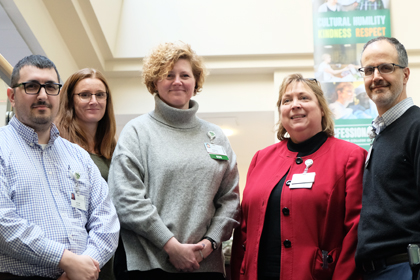Often-deadly blood clots are a common complication of cancer care, yet less than five percent of patients receive education on how to prevent them. A team of clinician-researchers at the UVM Cancer Center have published an evidence-based prevention “roadmap” found to reduce blood clots by 38 percent in the highest-risk patients.

L-R: Jacob Barker, PharmD.; Emily Parenteau, M.S.N., APRN; Karen Libby, BSN; Chris Holmes, M.D., Ph.D., Steven Ades, M.D., M.Sc. (Courtesy photo)
Often-deadly blood clots are a common complication of cancer care, yet less than five percent of patients receive education on how to prevent them. Now, thanks to a team of clinician-researchers at the University of Vermont (UVM) Cancer Center, an evidence-based prevention “roadmap”—found to reduce blood clots by 38 percent in the highest-risk patients—is available to direct providers and patients.
The American Society of Clinical Oncology (ASCO), a global leader in advancing oncology care, recently published the team’s findings.
Recognizing the complexity of addressing blood clots—clinically referred to as venous thromboembolisms (VTE)—in the patient setting, Holmes assembled a team, including physicians, advanced practice providers, pharmacists, and nurses, to develop a comprehensive education and intervention program. Called “Venous Thromboembolism Prevention in the Ambulatory Cancer Clinic,” or VTEPACC, the program offers individualized risk assessment and care recommendations for patients. More than 95 percent of patients received the blood clot education in the VTEPACC study.
“This was a significant clinical problem affecting many patients here at the UVM Cancer Center and nationally, but we knew we could do better,” says Holmes. “We’ve quickly adapted our intervention program to respond to patient care during the COVID-19 crisis as well: Our goal is to keep cancer patients safe—identifying patients at risk for blood clots, often in their legs or lungs, and providing the appropriate intervention, keeps patients safely at home and out of the hospital.”
The effectiveness of this multidisciplinary approach to VTE risk assessment and prevention in oncology patients underscores the need to leverage multiple areas of expertise to optimize clinical outcomes. The UVM Cancer Center’s implementation research has yielded a successful framework to make this happen. This national recognition of their program’s success means patients everywhere will benefit.
In addition to Holmes, co-investigators on the study include Steven Ades, M.D., M.Sc.; Susan Gilchrist, M.D., M.S.; Daniel Douce, MD, M.S.; Karen Libby, BSN; Britny Rogala, PharmD.; Emily Parenteau, MSN, APRN; Mary Cushman, M.D., M.Sc.; and Allison Kaigle Holm, Ph.D.